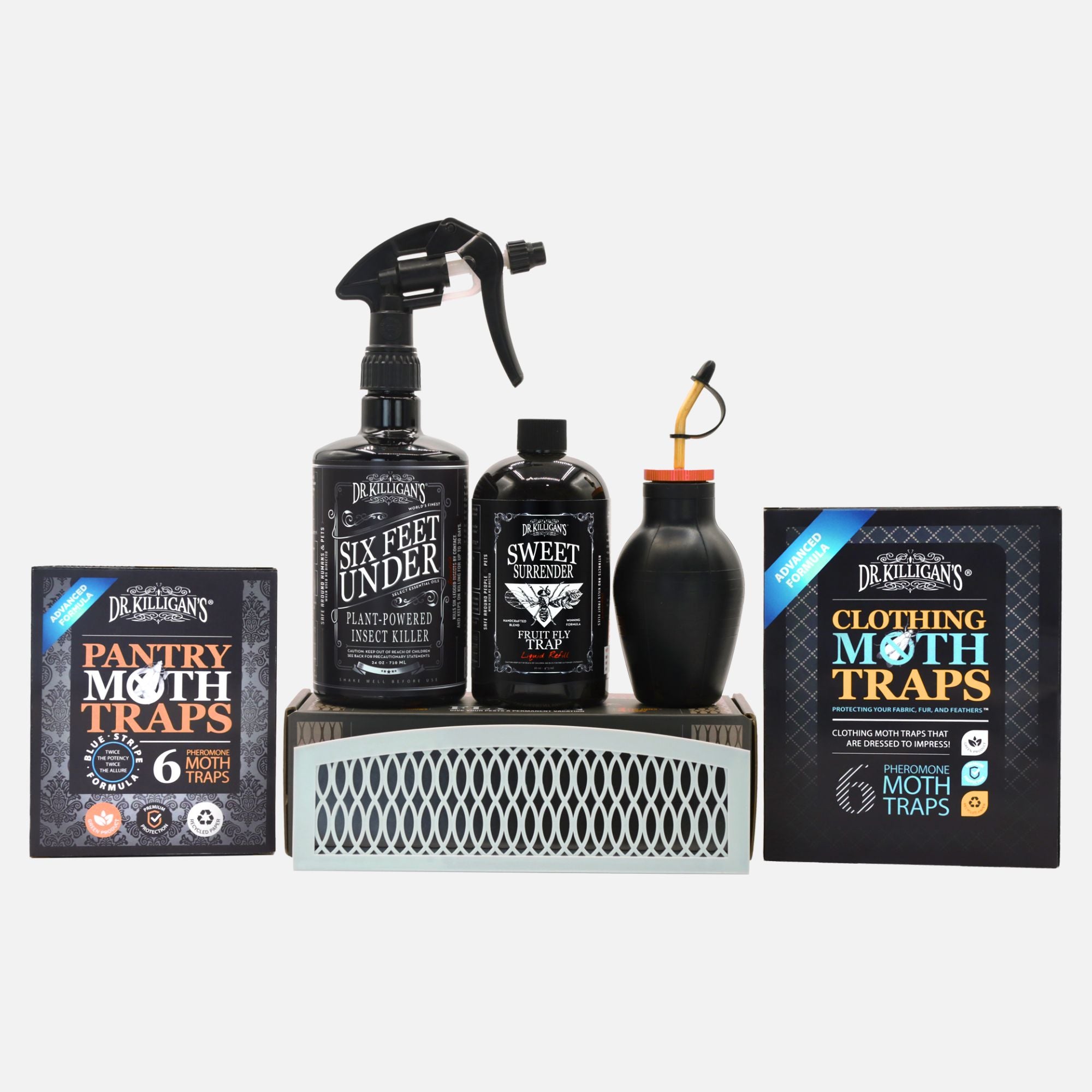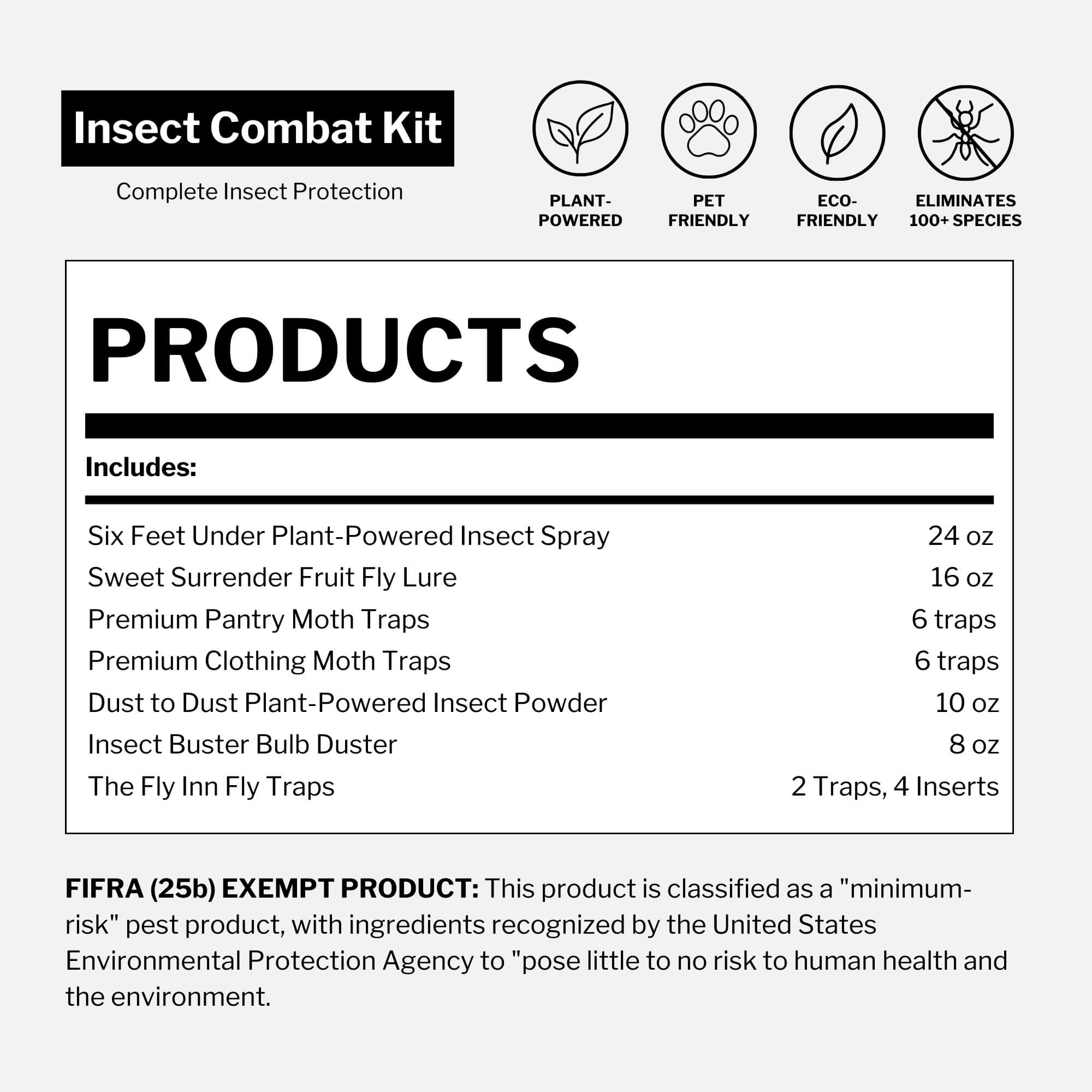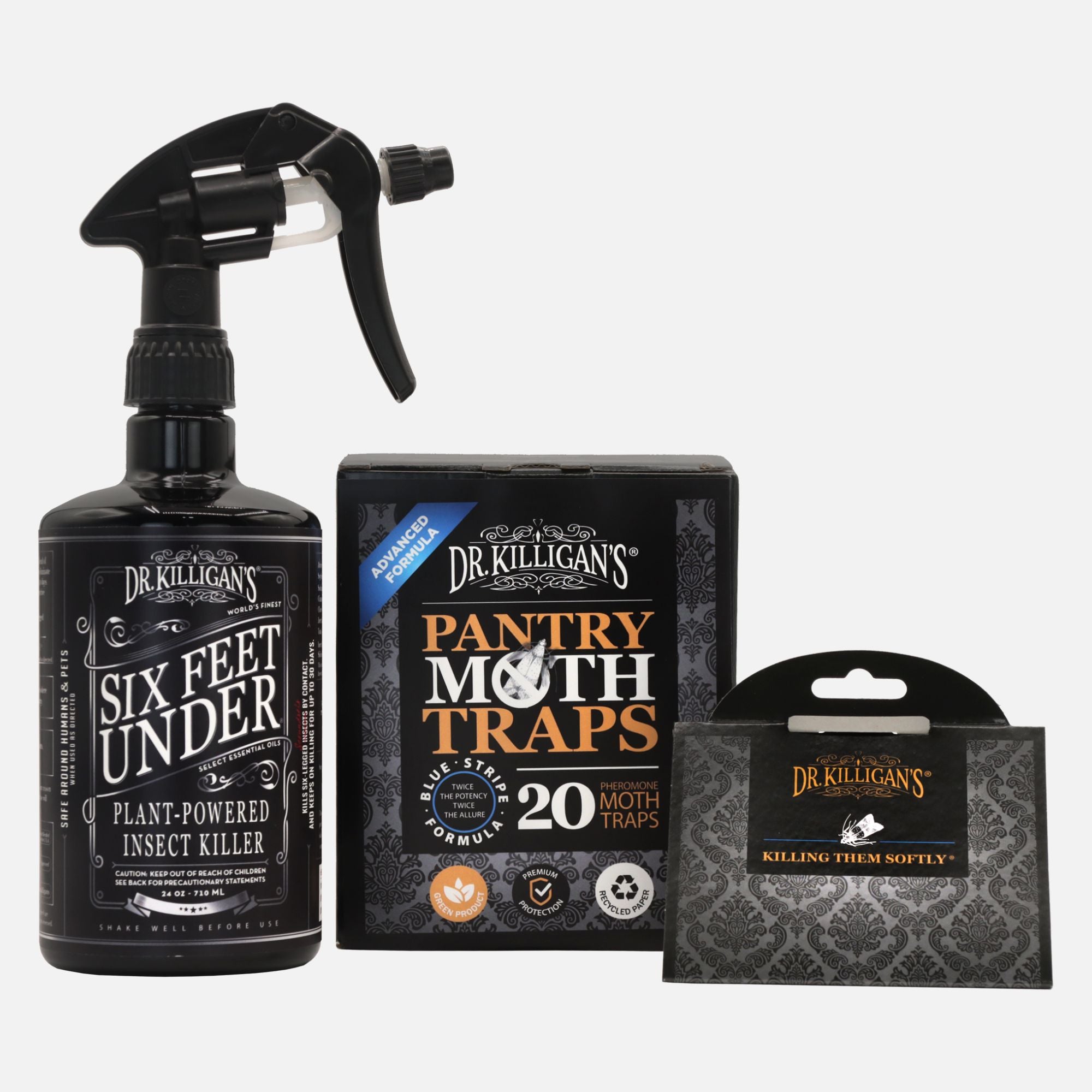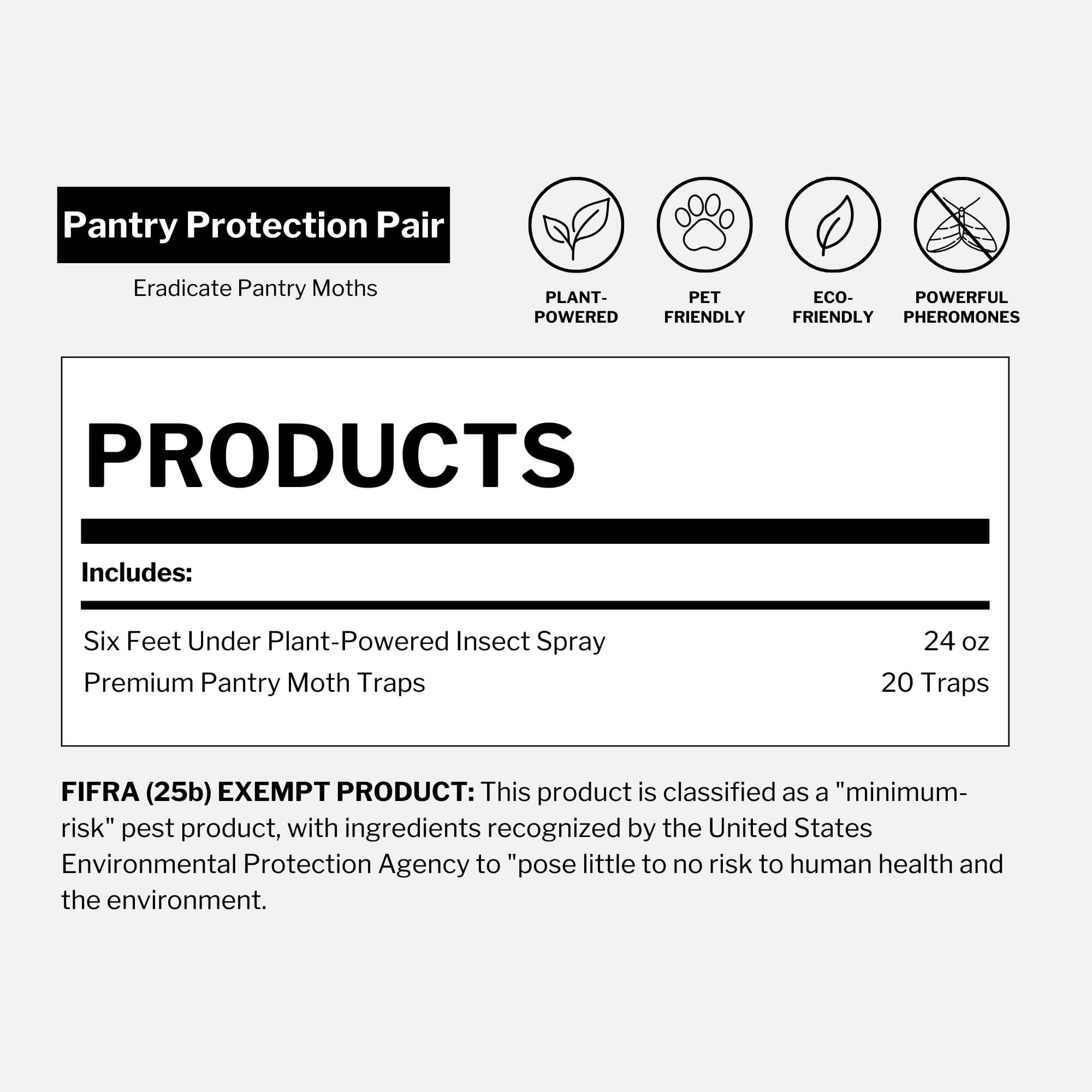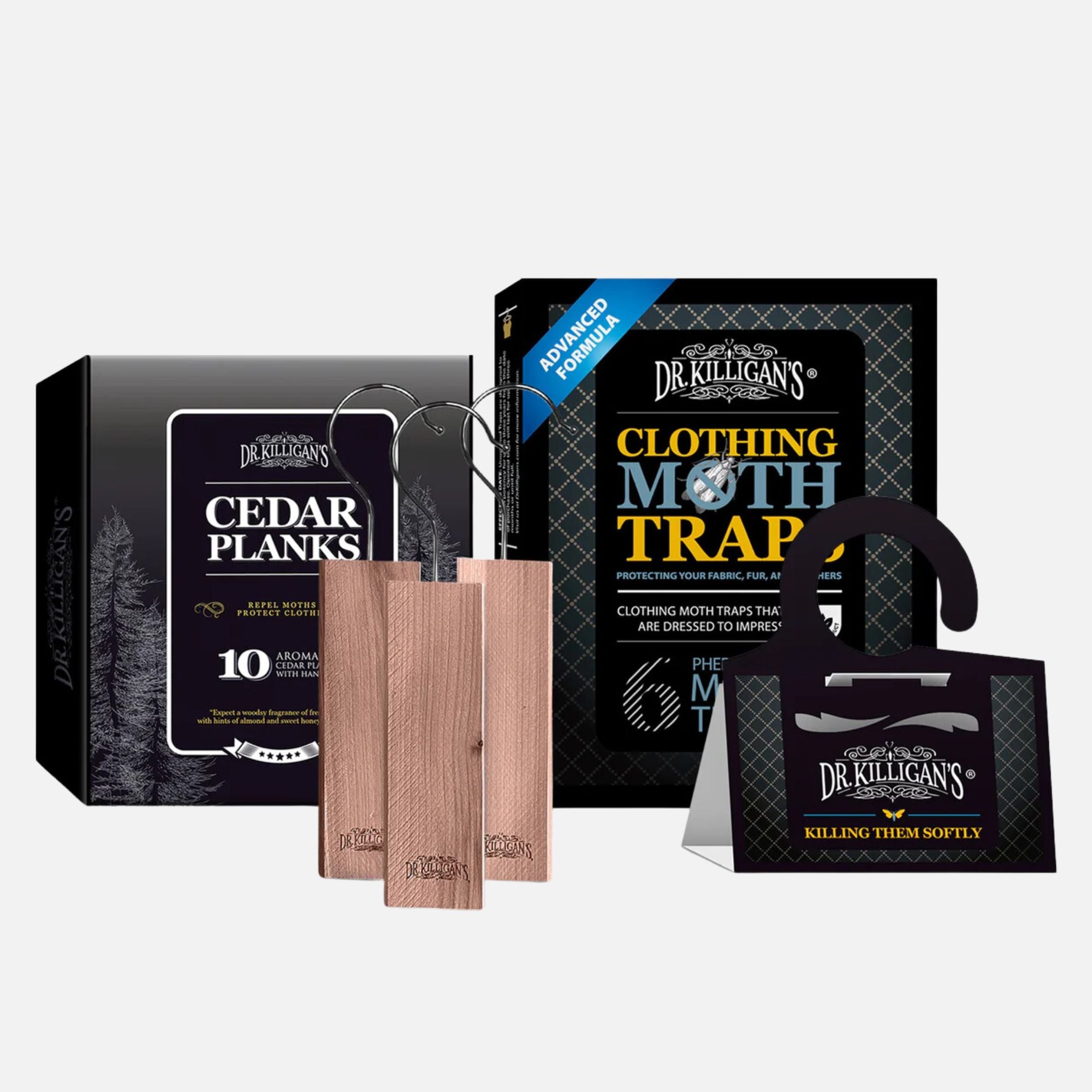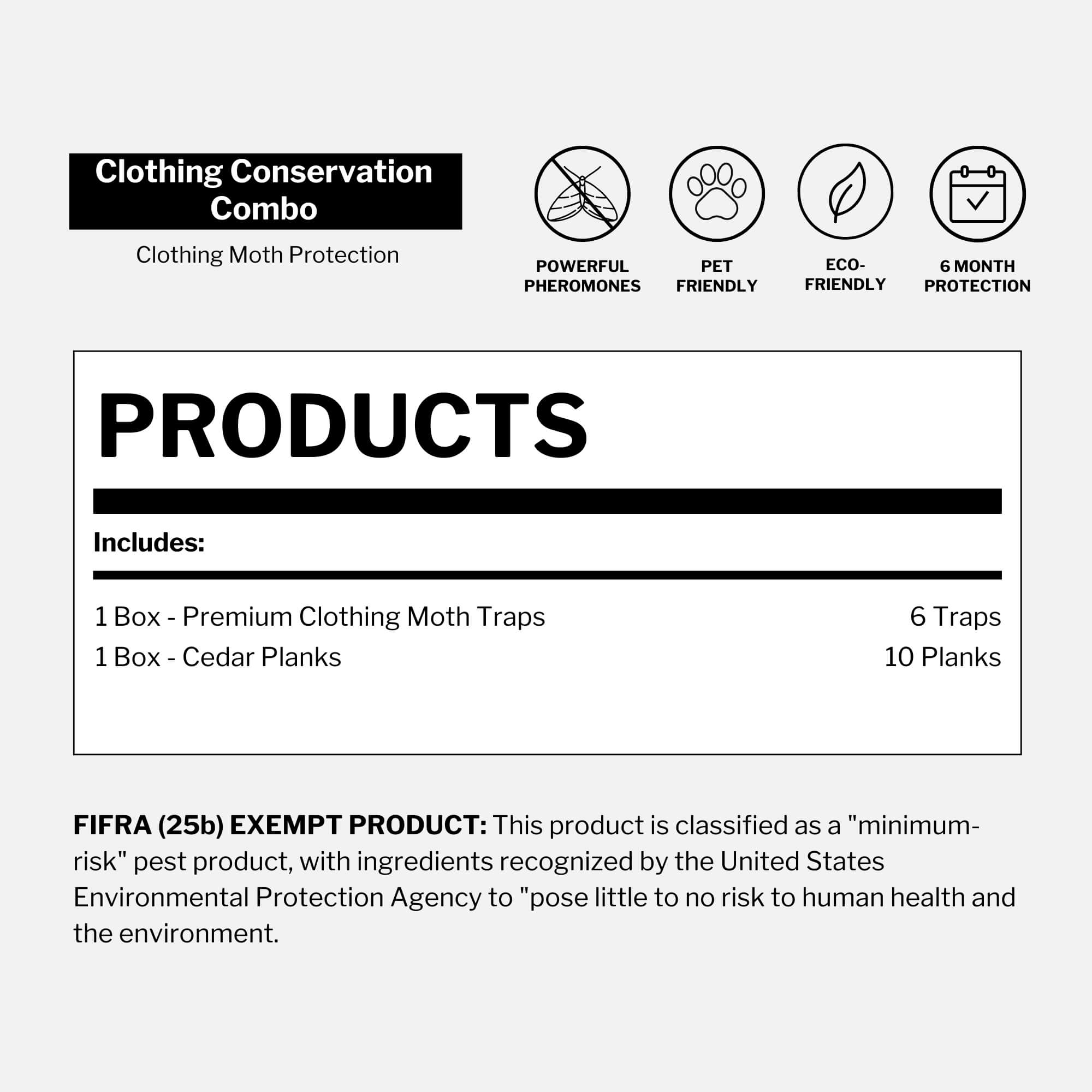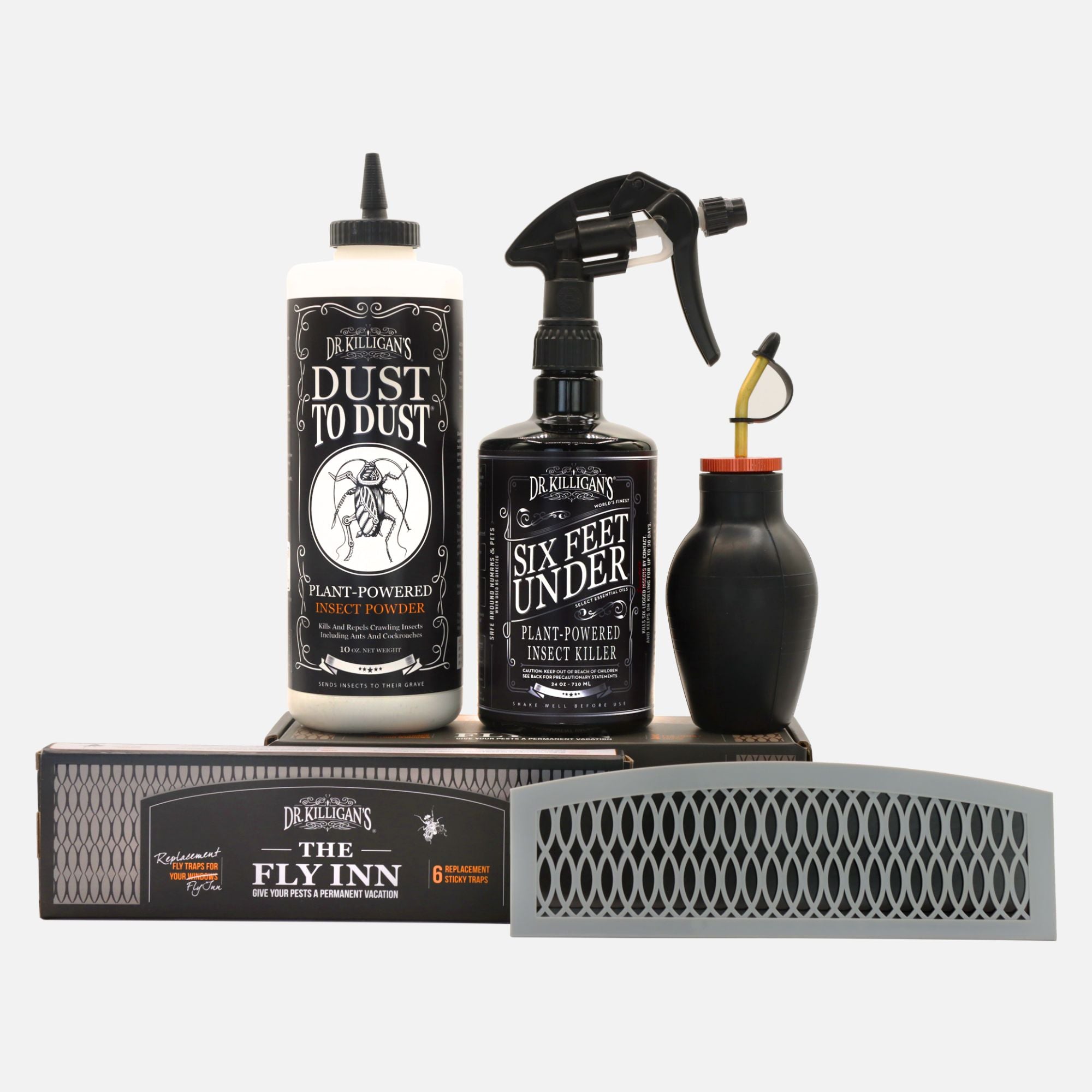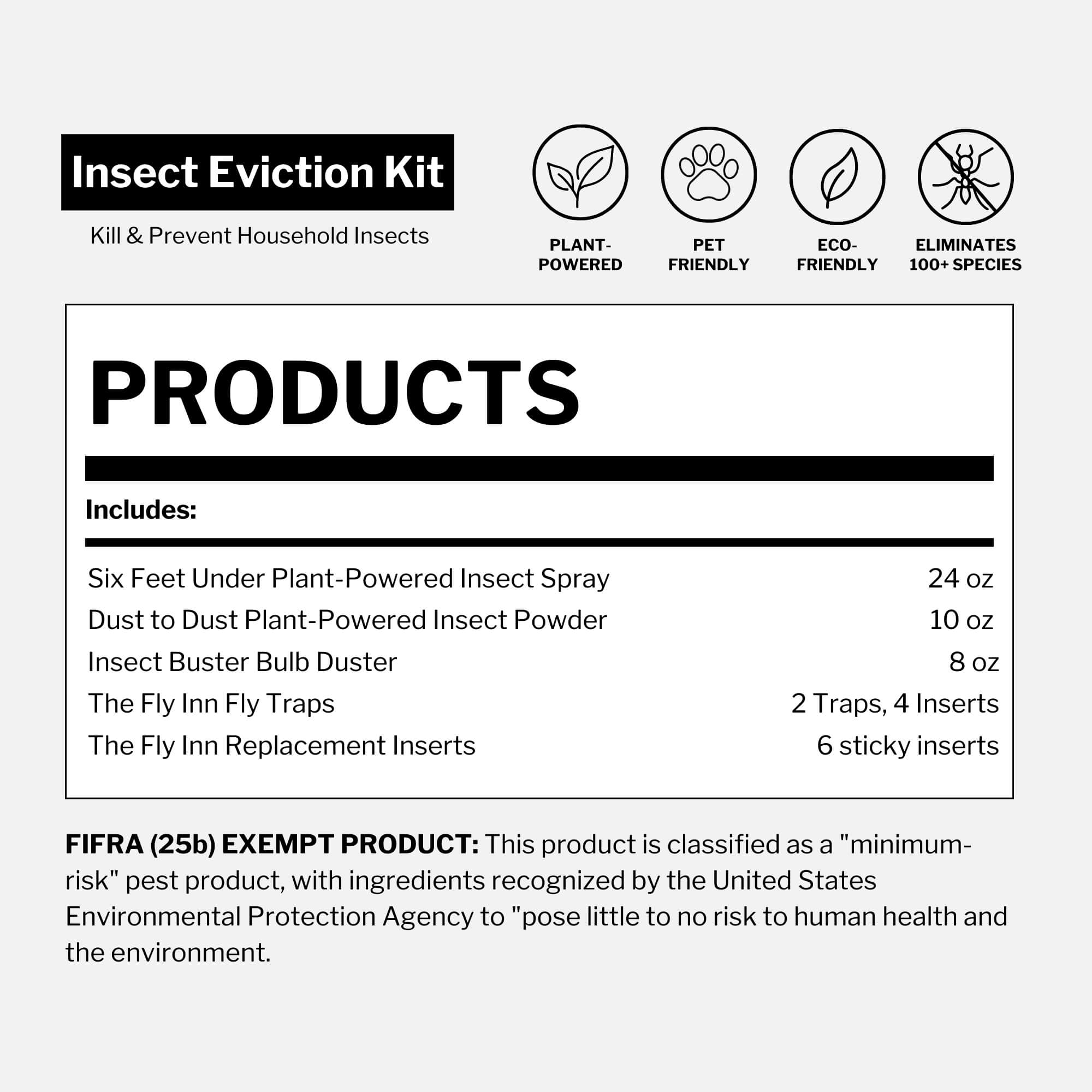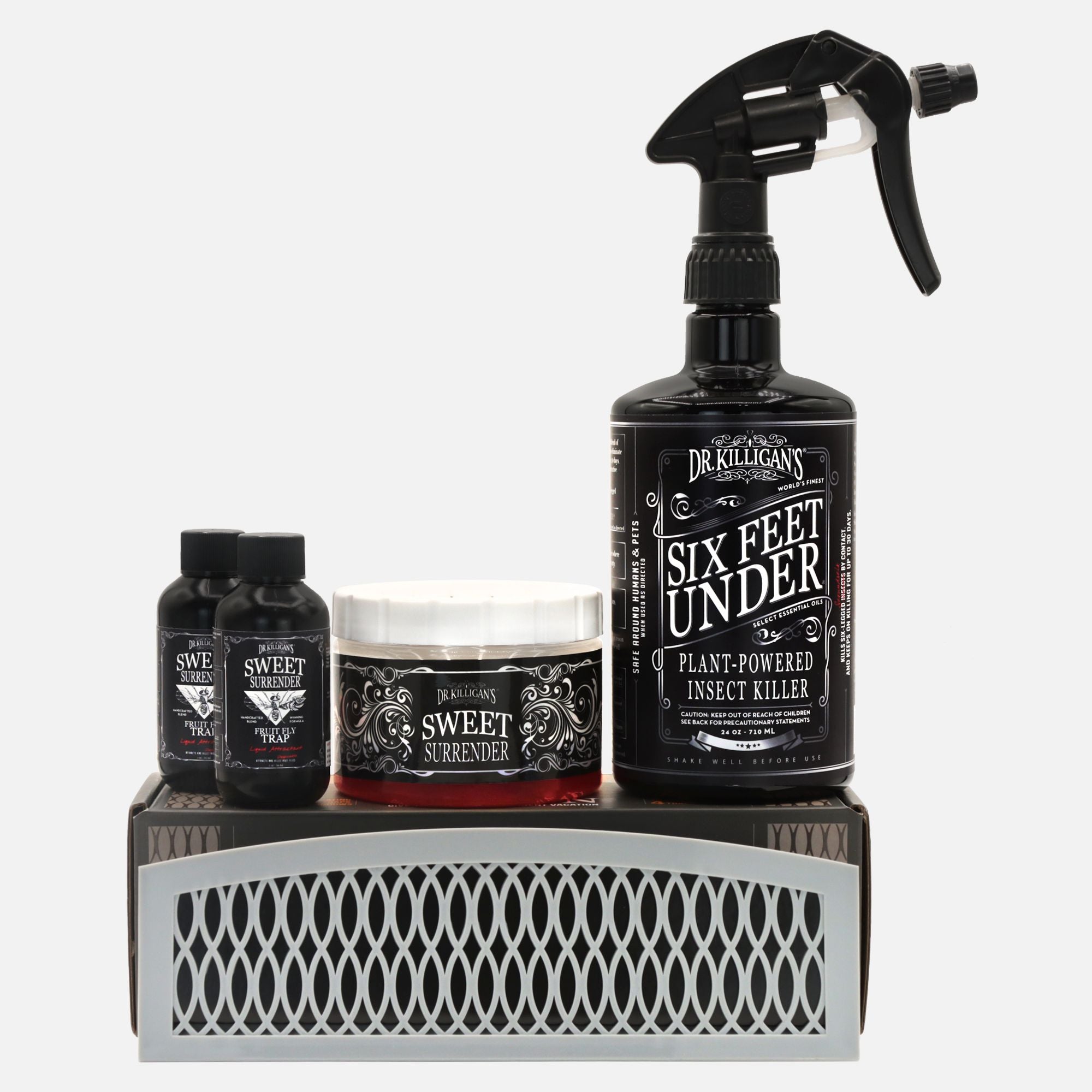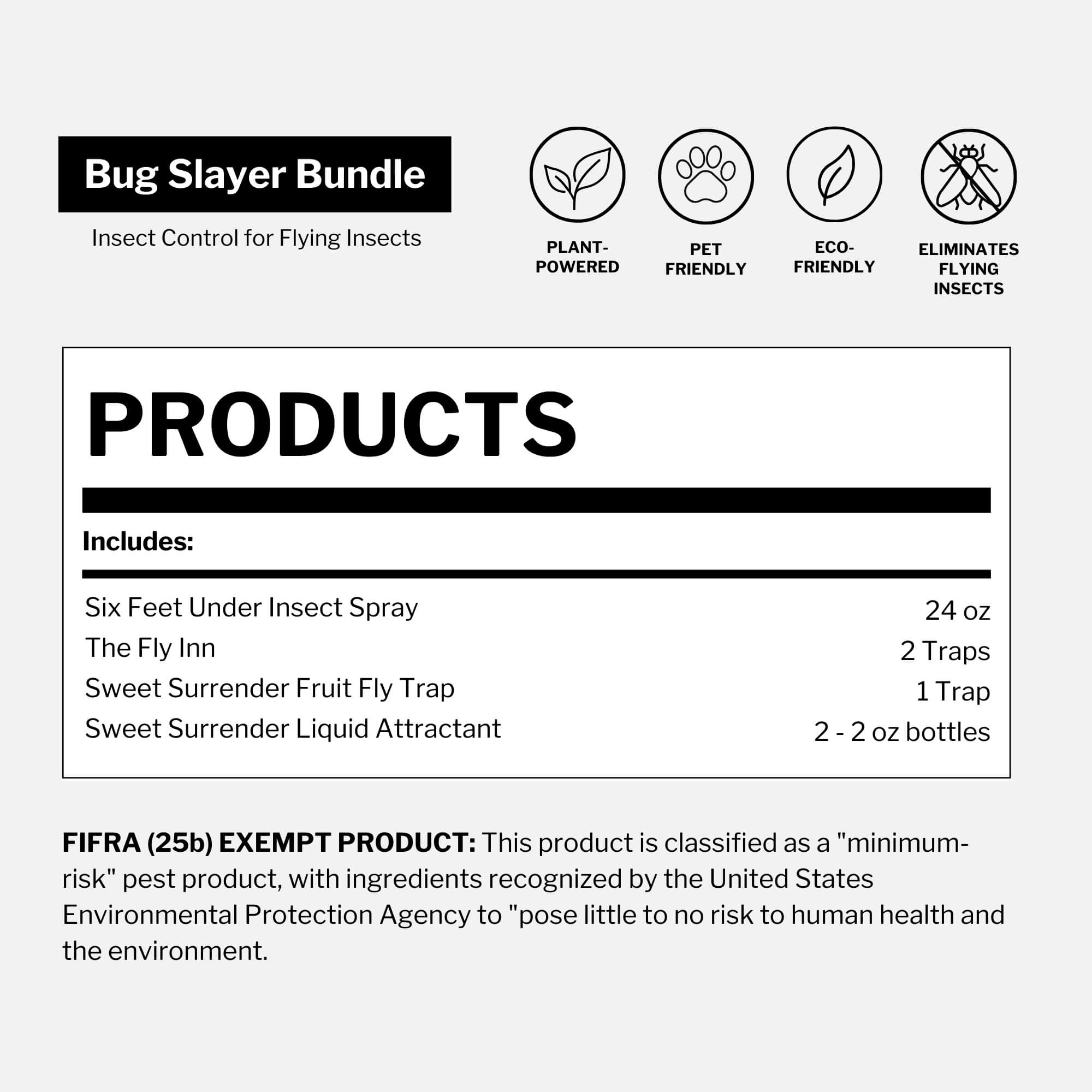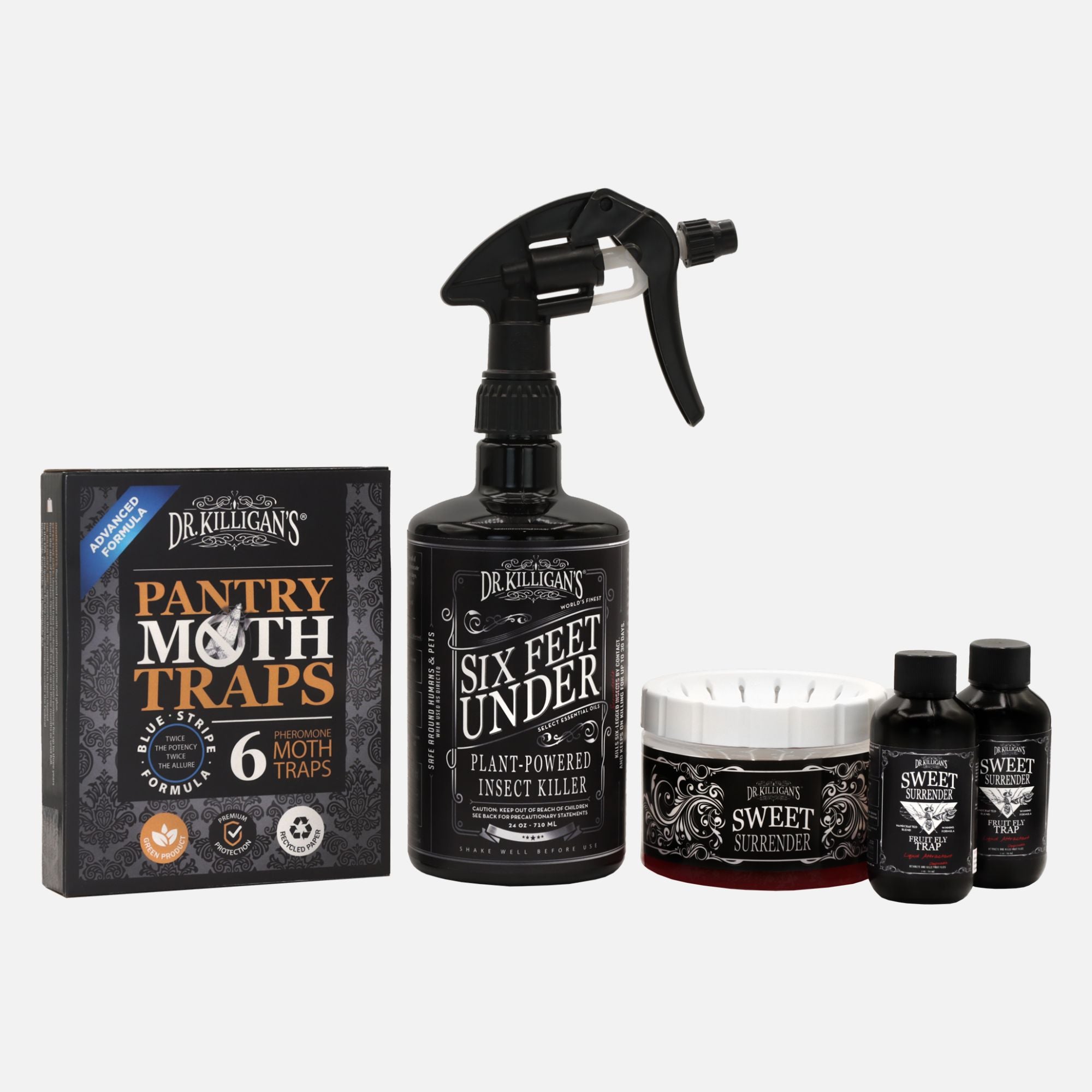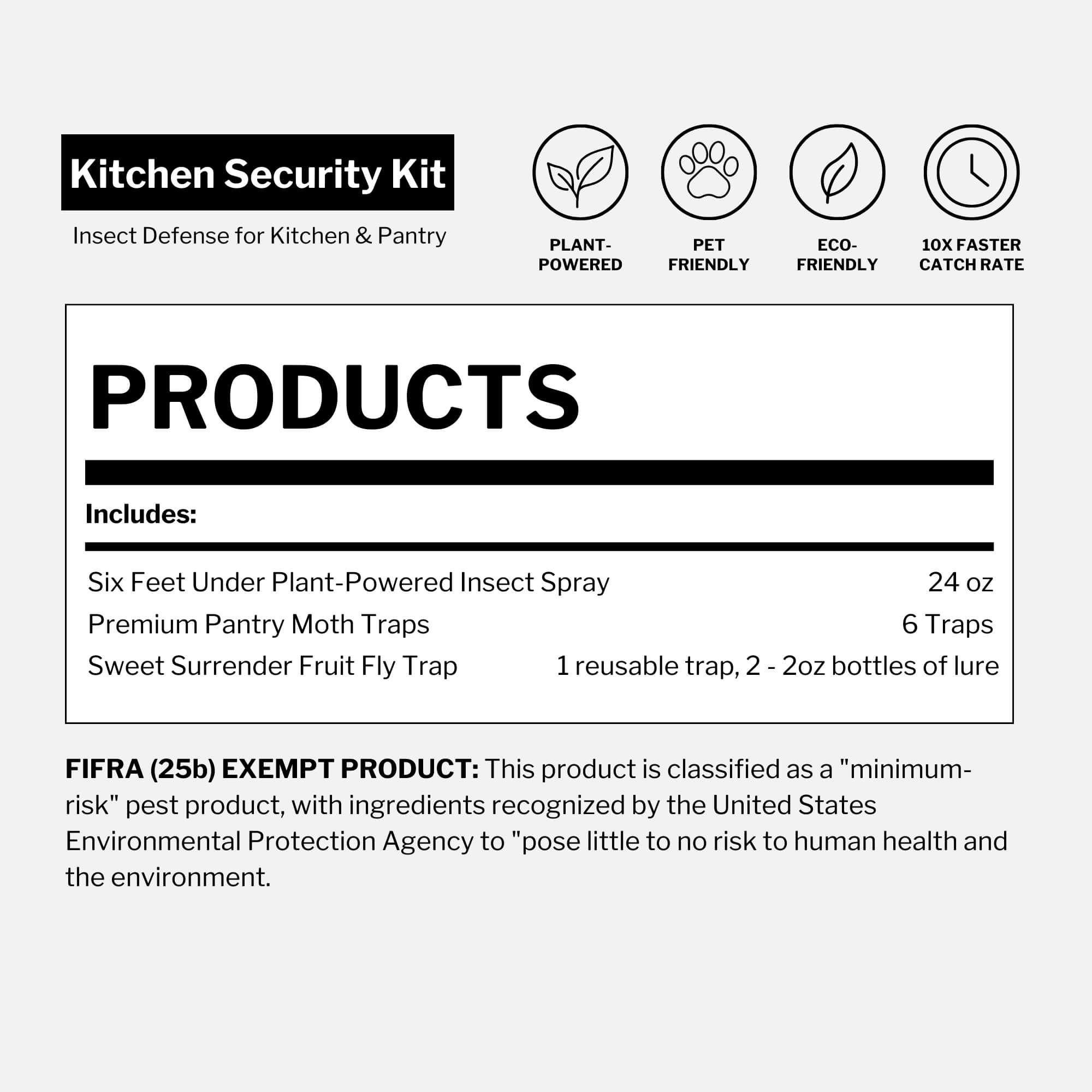Published May 16, 2022 • Updated October 17, 2025
Reviewed by Julie Miller, BA in Language Arts, Editorial Lead, Dr. Killigan’s
TL;DR: seal entry points, remove food and water sources, store dry goods sealed, reduce clutter, set target-specific traps and use plant-powered contact sprays for spot kill.
In this guide: Cockroaches • Ants • Flies • Mosquitoes • Pantry moths • Clothing moths • Fruit flies • Spiders
They may be breeding on the produce that you walk through your front door with, slipping in unnoticed when the screen door swings open in the wind, crawling in through a crack in your foundation or already wiggling around in that box of pasta. Either way, you want these bugs handled—quickly and cleanly.
Fear not: Dr. Killigan is here to help with pest knowledge and understanding, tips, solutions and infestation advice. Consider this Insect Combat 101—your guide to insect problems plaguing households near and far.
Cockroaches
 American cockroach (Periplaneta americana)
American cockroach (Periplaneta americana)
If a roach darts under the fridge, it’s time to act. Here’s how to get rid of cockroaches in the house.
Identify
- Common household species: German, American, brown-banded, smoky brown, Oriental
- Where you'll usually find them: kitchens, bathrooms, under sinks, behind/under appliances
- Early signs: pepper-like droppings, shed skins, egg cases in tight crevices
Quick answer
Cut moisture and remove food residue first. Then seal access points and treat cracks and crevices where roaches travel.
Prepare:
- Declutter kitchens and storage; remove cardboard stacks and paper bags
- Store food sealed; wipe crumbs and grease from counters, appliances and floors
- Fix leaks and drips under sinks and at fridge lines; dry sink rims and disposal collars
- Seal cracks and gaps at baseboards, pipe penetrations and cabinet joints
- Vacuum along wall—floor seams and inside cabinet corners
Where to look (common hideouts)
Behind or under refrigerators and stoves, under sinks and around plumbing penetrations, inside cabinet corners, drawers and pantry shelves, under small warm appliances like toasters and coffeemakers, along baseboards and wall—floor seams, in storage areas with cardboard or paper bags and around drains, pipes and faucet leaks
Why this works
Roaches follow moisture, food residue and tight shelter. Removing water and closing access points reduces rebound and makes treatment more effective.
Did you know
The fastest progress usually comes from fixing one moisture source (a drip, a damp sink rim) before adding more treatment.
Treat:
- Apply Dust to Dust Plant-Powered Insect Powder in thin, targeted lines with the Insect Buster where activity is found (cracks/crevices/baseboards). Avoid piles; reapply after deep cleaning, heavy moisture or if it has been removed
- In in-house testing, Dust to Dust showed kill times up to 70% faster than traditional DE
- When used as directed, it can keep killing bugs that cross the treated area for up to 30 days, as long as it isn’t washed away
- For visible roaches, use Six Feet Under Plant-Powered Insect Spray for contact kill
Monitor
- Check weekly for signs of activity behind/under appliances and under sinks (droppings, egg cases, shed skins)
Further reading: How to quickly get rid of American and German cockroaches • How to get rid of cockroaches
Ants

Carpenter ant (Camponotus)
When a line of ants cuts across the counter, don’t let it spread. Here’s how to get rid of ants in the house and stop them from coming back.
Identify
- Common household species: Argentine, odorous house, pavement, carpenter ants
- Where you'll usually see them: kitchen counters, baseboards, under sinks, around trash, pet bowls, window tracks and door thresholds
- Early signs: visible trails, repeated "scouts" showing up in the same spot, ants clustering near moisture or food residue
Quick answer
Wipe away food residue, dry up moisture and seal entry points first. Then treat the trail and entry seams so new scouts don’t reset the loop.
Prepare:
- Wipe crumbs and sweet or oily residues from counters, floors and appliances
- Store food sealed; empty trash and rinse recyclables
- Fix drips at sink, dishwasher and fridge lines; dry sink rims and disposal collars
- Seal entry gaps at baseboards, window tracks, door thresholds and pipe penetrations
Where to look (common hideouts / entry paths)
Along baseboards and wall—floor seams, under sinks and around plumbing penetrations, behind or under refrigerators and dishwashers, inside cabinet corners and pantry shelves, at door thresholds and window tracks and where exterior trails enter the kitchen or bath
Why this works
Ants follow steady food and moisture and scouts recruit more ants fast. Removing residue, drying leaks and closing entry points interrupts the trail cycle and reduces rebound.
Did you know
Many nuisance ants can form multi-queen “supercolonies,” so trails may reappear from multiple nearby nesting areas—another reason sanitation and sealing matter.
Treat:
- Use Six Feet Under—plant-powered contact kill with
clove &
cinnamon oils; provides residual protection up to 30 days
- Spot-treat trail start/end points if activity returns; reapply sooner after deep cleaning or when moisture is present
- In cracks and tight seams where ants enter, apply Dust to Dust with the Insect Buster in thin, targeted lines as directed
- Optional helper: a light wipe of peppermint or clove oil at door thresholds may discourage scouting ants (test a small area first)
Monitor
- Check daily for new trails along baseboards, backsplashes and under appliances
- Reduce moisture hotspots under the sink and around pet bowls
Learn more: How to get rid of ants • How to repel ants with essential oils • Will diatomaceous earth kill ants?
Flies

Drain flies (Psychodidae)
If flies cluster by the window or hover over the sink, it’s time to clear the air. Here’s how to get rid of flies in the house naturally and effectively.
Identify
- Common household culprits: house flies and drain flies
- Where you’ll usually see them: windows, trash/recycling areas, sinks and drains
- Early signs: flies reappearing daily in the same zones, activity near drains/trash, small flies hovering near sinks (often drain flies)
Quick answer
Remove the breeding source first (trash, residue, drain film). Then use targeted traps and spot treatment where flies gather—especially windows and sinks.
Prepare:
- Keep indoor trash cans closed and clean; wipe sticky residues on counters, floors and appliances
- Deep-clean drains and disposals; rinse recyclables and bottles
- Install tight screens and repair tears; keep doors closed or use a screen door
- Store produce covered or refrigerated; empty compost caddies often
- Seal pet food in lidded containers and clean bowls nightly
- Keep outdoor bins closed, clean pet areas and maintain compost properly to limit breeding nearby
Where to look (common hideouts / source zones)
Sunlit windows and glass doors, around trash and recycling lids, sink rims and disposals, floor drains, under appliance kickplates, compost caddies and sticky spill zones, plus nighttime resting spots on ceilings, walls and curtains
Why this works
Flies breed where damp organics and residue build up. Light and airflow patterns draw adults to windows and doors, while drains and trash keep the cycle going if they aren’t cleaned.
Did you know
Many flies naturally head toward light—so window clustering is a useful clue for where to focus control.
Treat:
- Place The Fly Inn Flying Insect Trap on busy windows (where you see the most activity), as directed. Adjust placement if catches slow down
- For visible flies, use Six Feet Under for contact kill
- For drain flies, scrub inside the drain walls with a brush and flush with hot water after using a suitable cleaner; repeat until activity stops
- Maintain traps; replace when full
Monitor
- Check window sills and near lights daily for landings and new activity
- Inspect sink rims, overflows and drain covers weekly for organic film
Further reading: What attracts flies and the colors they’re drawn to • How to get rid of flies in your house (the right way) • How weather affects flies and mosquitoes
Mosquitoes

Yellow fever mosquito (Aedes aegypti)
When mosquitoes swarm at dusk on the patio, you need quick relief. Here’s how to get rid of mosquitoes around the house and reclaim your evenings.
Identify
- Common backyard culprits: container-breeding mosquitoes that use small pockets of standing water
- Where you'll usually notice them: patios and porches at dusk, shady yard edges, near doors/screens
- Early signs: bites showing up after outdoor time, mosquitoes hovering in shaded spots, standing water that doesn’t dry out in 2–3 days
Quick answer
Dump standing water first. Then block entry (screens) and use airflow (fans) where you sit. Treat only when you see active mosquitoes.
Prepare:
- Dump standing water every 3-4 days: buckets, plant saucers, toys, tarps, wheelbarrows, grill covers
- Clear gutters and downspouts so water doesn’t pool
- Refresh birdbaths and pet bowls frequently; store watering cans upside down
- Fix yard drainage low spots; level or fill dips that collect water
- Screen rain barrels with fine mesh and keep lids tight
- Cover hot tubs and pools; drain water off pool covers
- Snap trash-can lids tight; rinse sticky residue
- Install tight window and door screens; repair tears and add door sweeps
- Use fans where you sit outdoors to disrupt flight near people
Where to look (common hideouts / source zones)
Plant saucers and tray bottoms, clogged gutters and downspouts, buckets and toys left outdoors, tarps and grill covers that hold puddles, old tires, wheelbarrows, open rain barrels without screens, landscape low spots and dense, shaded vegetation near damp soil
Why this works
Mosquitoes lay eggs on or near still water. Even small amounts left for several days can support larvae. Removing water stops breeding at the source and screens + airflow reduce bites where you live and relax.
Did you know
Many mosquitoes stay close to where they hatch—so fixing standing water on your property can reduce bites faster than treating “everywhere.”
Treat:
- For visible mosquitoes, use Six Feet Under for spot treatment (contact kill), as directed; avoid spraying in breezy conditions and around pollinator-attractive blooms
- Use fans during outdoor time to keep mosquitoes away from seating areas
Monitor
- Do a weekly yard walk after rain and tip or toss anything holding water
- Check gutters, drain trays, plant saucers and shaded corners that stay damp
- Note peak times (usually dusk) and locations to focus your efforts
Learn more: How weather affects flies and mosquitoes • Mosquitoes: More than just pests—surprising ecological benefits revealed
Pantry Moths

Indian meal moth (Plodia interpunctella)
If tiny moths flutter near your shelves or dry goods, act fast. Here’s how to get rid of pantry moths and protect your food stores.
Identify
- Common household culprit: pantry moths (often Indian meal moths)
- Where you’ll usually see them: pantry shelves, dry goods cabinets, bird food storage, ceiling corners near kitchens
- Early signs: small moths near shelves, webbing/clumping in dry goods, larvae or tiny “worms” near package seams
Quick answer
Find and remove the infested food source first. Then deep-clean the pantry, move everything into airtight containers and use traps to help reduce the breeding cycle.
Prepare:
- Inspect all dry goods for webbing or larvae; check seams of bags and boxes, under lids, corners of shelves
- Check edges of cans and spice jars, inside lid threads and even unopened packages for hidden larvae
- Toss heavily infested items; for questionable items, freeze 48–72 hours in sealed bags to stop hidden stages
- Vacuum shelves, crevices and shelf-pin holes; wipe with warm soapy water or vinegar and let dry fully
- Store flour, grains, cereal, nuts, seeds, baking mixes and pet food in airtight, hard-sided containers
-
Quarantine new dry goods in sealed bins for 1–2 weeks or decant into containers on day one
Where to look (common hideouts / source zones)
Flour and cereal bags, rice and grain bins, nuts and seeds, baking mixes, dried pet food and birdseed, shelf corners, under shelf liners, inside shelf-pin holes, inside lid threads and bag folds
Why this works
Pantry moth larvae can develop inside packages and spill zones. Thin plastic and cardboard don’t reliably block access to food, so airtight containers remove the food supply. Cleaning removes eggs/larvae hiding in cracks and traps help reduce mating pressure over time.
Did you know
Most pantry moth problems ride in with packaged dry goods. Quick inspections on grocery day prevent weeks of cleanup.
Treat:
- Place Dr. Killigan’s Pantry Moth Traps (often 2–3 per area) where moth activity is highest, as directed. If you’re still seeing moths but catches are low, reposition traps—small placement changes (shelf height/airflow/near food zones) can make a big difference.
- For visible moths or larvae on surfaces, use Six Feet Under for spot treatment (contact kill), as directed.
- Repeat the clean-inspect-trap routine for several weeks to cover egg-to-adult timing
Monitor
- Check Pantry Moth Traps weekly and replace when full
- Reinspect shelves and container lids for new webbing or clumped food
Learn more: How long does it take to get rid of pantry moths • Beyond breadcrumbs: 7 unexpected places you might find pantry moths • Will eating a pantry moth make you sick?
Clothing Moths

Common clothes moth (Tineola bisselliella)
Notice moths drifting from the closet or damage in your wool? Here’s how to get rid of clothing moths and prevent wardrobe damage.
Identify
- Common household culprits: webbing clothes moths and casemaking clothes moths
- Where you’ll usually see them: closets, drawers, storage bins, rug edges, tucked-away wool or silk items
- Early signs: small moths in undisturbed areas, irregular holes in wool/cashmere, silk-like webbing, sand-like frass or larvae/cases in seams and corners
Quick answer
Treat the garments first (clean, heat/steam or freeze), then deep-clean the closet and switch to airtight storage. Use traps to reduce the breeding cycle and keep pressure down.
Prepare:
- Launder or dry clean wool, silk, cashmere and blends before storage; let items dry fully
- For washable items, use hot water over 120°F or steam where fabric care allows
- Declutter closets; vacuum floors, shelf edges, baseboards and corners
- Store off-season garments in airtight garment bags or sealed bins
- Move garments regularly; improve light and airflow so areas aren’t dark and undisturbed
Where to look (common hideouts / source zones)
Under collars and cuffs, seams and hems, inside pockets, wool throws and felts, stored furs, feather accessories, rug edges and under furniture, piano felt pads, animal-bristle brushes and undisturbed closet corners
Why this works
Clothing moth larvae feed on animal fibers (like wool and silk), especially where body oils or food stains linger. Cleaning and airtight storage remove the “fuel,” while vacuuming and targeted treatment reduce what’s already in the space.
Did you know
Most fabric damage shows up along seams, cuffs and collars—where body oils collect and larvae feed more readily.
Treat:
- Isolate affected garments; freeze in sealed bags 48—72 hours or dry clean per fabric care
- Place Dr. Killigan's Clothing Moth Traps at closet entry and near storage bins, as directed, to help interrupt breeding and track activity
- Add Cedar Planks to closets/drawers as a supportive deterrent (use alongside cleaning + traps, not as a stand-alone fix)
-
Cedar only works when it smells—refresh scent with Cedar Ward Cedar-Rejuvenating Spray or a light sanding when aroma fades. Avoid direct contact with delicate fabrics; place near (not on) garments
- Wipe hard surfaces, shelves and baseboards with warm soapy water, vinegar or Six Feet Under; let dry fully
Monitor
-
Check traps weekly and replace as needed
-
Recheck rarely worn items monthly, plus rug edges and storage zones
- Keep an eye out for new holes, webbing, frass or larvae/cases—activity can lag a few weeks after initial cleanup
Tip
After sweaty workouts, don’t re-shelve garments—wash or air and clean first to remove the scents larvae follow.
Further reading: 11 tips on how to prevent a clothing moth infestation • Pantry moths vs. clothing moths • Where do clothing moths come from?
Fruit Flies

Fruit fly (Drosophila melanogaster)
When fruit flies hover over the bowl or drain, don’t wait. Here’s how to get rid of fruit flies in the house and keep them from returning.
Identify
- Common household culprit: fruit flies (often breeding in fermenting produce + residue)
- Where you’ll usually see them: fruit bowls, trash/compost, recycling, sinks/drains, near sticky spills
- Early signs: tiny flies hovering near produce or sinks, flies “resetting” daily, activity near drain overflows or recycling
Tip
Fruit flies are often mistaken for gnats—gnats look more like tiny mosquitoes; fruit flies look like mini house flies.
Quick answer
Remove the breeding source first (overripe produce + sticky residue + drain film). Then set a trap in the hottest zone and spot-treat adults you see while the cleanup works.
Prepare:
- Clear the food source: discard overripe produce and sticky spills on counters, floors and appliances
- Store fruit covered or refrigerated; rinse bottles and recyclables before binning
- Deep-clean drains and disposals: scrub the inner walls, then flush with hot water after a cleaner
- Wash mop heads and dishcloths; empty compost caddies often and wipe lids
- Keep trash can lids snapped tight and the can interior clean
Where to look (common hideouts / source zones)
Fruit bowls and produce drawers, sink rims and disposals, drain overflows, recycling bins and bottle crates, trash can lids and seams, compost caddies, mop buckets and sponge trays, sticky spill zones under small appliances
Why this works
Fruit flies breed in fermenting residue and damp organic film (produce juices, trash “goo,” recycling residue, drain slime). Removing the food + film breaks the lifecycle; traps pull in adults so the population drops while you clean.
Did you know
Fruit flies lay eggs on moist, sugary surfaces—banana stems, juice rings under bottles and film inside sink overflows are common “hidden nurseries.”
Treat:
- Set Sweet Surrender Fruit Fly Trap near the highest activity area, as directed (fruit bowl zone, trash/compost area or near the sink). If catches are low but flies persist, move it 3–6 feet and try again—placement matters
- For visible adults, use Six Feet Under for contact kill
- If the issue is actually drain flies, scrub inside drain walls and under stoppers to remove slime, then flush with hot water; repeat daily 3–5 days, then do weekly maintenance
- Optional DIY drain clean: pour ½ cup baking soda + ½ cup salt into the drain, add 1 cup vinegar, wait 2 hours, flush with hot water
Monitor
- Check Sweet Surrender daily for the first 3 days, then 2—3x per week; replace when full, evaporated or at up to 6 weeks after opening
- Watch fruit bowls, compost caddies, sink rims and drain overflows for landings; reposition traps toward the most active spot
- If flies persist but catches drop: refresh the attractant (if applicable) and re-check drains/disposals + sticky spill zones, then adjust placement again
- Expect spikes after produce runs and in warm, humid late summer to early fall—keep an extra trap ready
Further reading: Vinegar vs. fruit flies—what really works? • Phorid flies vs fruit flies: Key differences and how to deal with them
Spiders

Wolf spider (Lycosidae)
If webs appear in corners or a spider crosses the wall, take control. Here’s how to get rid of spiders in the house and keep them out.
Identify
- Common household culprits: house spiders, cellar spiders, wolf spiders, jumping spiders
- Where you’ll usually see them: ceiling corners, window/door frames, basements/garages, behind furniture, near porch lights
- Early signs: fresh webs, egg sacs, repeated sightings in the same corner/room
Quick answer
Remove webs and reduce indoor insects and entry (clean, seal, adjust lighting). Then treat entry seams and common travel paths so new spiders don’t keep showing up.
Prepare:
- Vacuum ceiling corners, window sills, wall–ceiling junctions and baseboards; knock down indoor and outdoor webs
- Reduce clutter in basements, garages and closets; store items in sealed bins instead of cardboard
- Seal gaps at door sweeps, window frames and utility penetrations; repair screens
- Swap bright exterior bulbs for warmer LEDs or motion lights and keep bright fixtures away from doors
- Tidy outdoor zones: move firewood and debris off the house, trim vegetation off siding, clear cobwebs from eaves, locate compost/trash away from entries
- Dry damp areas with ventilation or a dehumidifier; fix leaks under sinks and in crawl spaces
Where to look (common hideouts / source zones)
Ceiling corners and wall–ceiling seams, behind and under furniture, window and door frames, basements and crawl spaces, garages and storage rooms, exterior eaves and soffits, around porch lights and stacked firewood
Why this works
Spiders follow shelter and prey. If you reduce insects (especially around doors and lights) and remove harborage (clutter + moisture), spider activity drops—and sealing gaps limits new ones coming in.
Did you know
A single spider egg sac can hold dozens to hundreds of eggs—removing sacs is one of the fastest ways to cut future activity.
Treat:
- For visible spiders, use Six Feet Under for spot treatment (contact kill), as directed
- After cleaning, apply Dust to Dust with the Insect Buster in thin lines along baseboards, garage thresholds, utility entry points and other travel seams as directed
- Vacuum webs and egg sacs directly and discard the vacuum contents outdoors
Monitor
- Once a week, sweep for fresh webs and egg sacs in corners, window frames and storage areas
- Note where spiders appear at night around porch lights and doorways; that’s where exterior cleanup matters most
Learn more: Which spiders are living in my home? • How long can spiders live without food?
Ready to put pests on notice?
Build your targeted toolkit. Six Feet Under (spot treatment), Dust to Dust + the Insect Buster (cracks/crevices), plus pest-specific traps (Pantry Moth Traps, Clothing Moth Traps, The Fly Inn, Sweet Surrender). For an all-in-one option for high-traffic zones, try Six Feet Under: Barricade Household Insect Kit (contact kill + residual barrier). Need help choosing? Contact support.




